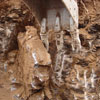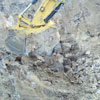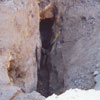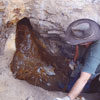Graveyard Point Mining Operation 2011

In April, I asked Gary McFarlane if he would like to accompany me to Graveyard Point to dig a little agate in June. Gary has been a companion on several of my mining operations. My friend Jake was planning on helping also but was still recovering from his brain surgery last October. Phillip Stevenson from Boise had contacted me earlier in the month about being with us for the whole mining operation, and said he would meet us when the excavator was delivered. Gary enthusiastically consented, and we left Wisconsin on June 2 for Idaho.

This year’s mining operation at Graveyard Point started without too many problems until we got to the river. First, my account card that allowed us to buy off road diesel for the excavator did not work. Second, when the machine was delivered to the drop off point above the canal outlet, the second bucket I had ordered for the machine was not on the truck. This year I rented an excavator with a quick-change bucket system so I could use two different sized buckets -- one bucket for digging rock and the other for moving muck.
The previous few years, I have been getting deeper and deeper following the agate in the ground, and since I have to reclaim everything every year, more and more waste rock has to be moved before I can start mining agate again. Having the bigger bucket would allow for much less time to remove all the previous years’ reclaimed muck. Both of these problems were solved relatively easily in a short period of time. The Caterpillar dealership sent a truck and trailer out to the mine site with the bucket, and the computer glitch at the off–road diesel pump was fixed.
As I have explained in previous reports, the excavator on a truck is too heavy to cross any of the bridges over the canal. The machine has to be dropped off at the canal outlet and driven on roads that are on the other side of the canal, thus we must drive through Succor Creek. The river crossing is about half way to the mine from the drop off point. Because of the cold wet spring, the river was running high, and its banks were muddy from when the river was even higher. Jake drove the excavator through the river and waited on the other side. After some discussion, I decided to try to drive my truck through after the machine. The river bottom here is solid and rocky, but both banks had a lot of soft mud. I got through the river ok but barely made it out of the creek on the other side.

Phillip was in his truck behind me. After he saw that I was able to get my truck out on the other side, he dove in with his Suburban. When he got to the mud on our side of the creek he got stuck. When you are in a river with your truck running and the water is above your tail pipe and running into your vehicle, you have to keep the engine running at the same speed. You can’t shut the engine off or get out of the vehicle or the water will get into the engine and ruin it. So there was Philip sitting in his truck, keeping the engine running, with water creeping in the back end. Luckily the excavator was right there. I got a logging chain out of my truck (an essential tool for any mining operation), waded down into the water and hooked a chain up to the front of his truck. I hooked the other end of the chain to the bucket of the excavator, and Jake pulled his truck up through the mud onto dry land.
A few hours later we were all at the mine site. We drove back into town to get my travel trailer and Jake’s truck with two barrels of diesel fuel. By the time we got back to the site with the trailer the missing bucket had been delivered.
This year I had two things I particularly wanted to do. I wanted to spend some of our mining time on the North end of the claim where there are larger blue agate veins with white plumes. This agate can also have dark marcasite halos and some colored plumes. I also wanted to dig to the bottom of the cave. There is no particular economic value in this effort; I just wanted to see how deep the crack in the earth went.


After we set up camp, Gary and I walked down on the North end of the claim to decide where to dig. The next morning, I drove the excavator down and positioned it in the bottom of the ravine a little further up the draw from where I had worked eleven years previously. Gary, Phil, and Jake acted as "spotters" while I started to dig into the side of the hill. Because of the unusually wet spring, everything was muddy. The basalt was easier to dig and seemed to separate easily but it was also hard to detect the agate unless it was broken. Not an hour went by before a natural crack started to develop a wall in the pit. Phil stopped me and said, "You’d better come down and look at this!" We all crawled down into the muddy hole, and — much to my surprise — it appears that the whole wall was agate!
I repositioned the machine to try and work alongside the agate and dig the hole deeper into the bank. After not too long, straight ahead of the machine, I hit a rock that was obviously another piece of agate. This turned out to be another large vein running at right angles to the first one. I carefully worked the basalt away as best I could with the excavator until the agate vein was exposed. I then put the tooth of the bucket behind the vein and gently pulled it away. In a very short time we had a pile of agate that was 600–700 pounds.

In less than two days, we dug over a ton of agate from an area that was maybe 30 by 40 feet. All the extra material that we removed was then put back into the hole and contoured to the slope of the hill. We then moved our operation back over to the Regency Rose area of the claim.
Jake drove the machine, rerouted the road around our work area and started the arduous task of moving muck to try to find where we left off last year. Even with the larger bucket, this process took over a day’s work. Jake and I decided to build the access road to the cave area further to the West, and we started it further to the South. This would allow us to get the machine deeper into the ground. In doing this we discovered that the basalt to the West of the cave is not as far under the clay as we had thought, and we actually hit some agate before we got to the cave area. The agate here was heavily plumed but also had some soft spots and holes. We did however get some good agate here. It appears the agate continues in the basalt to the North.
Last year, I could not work in the cave itself because we hit this Pink plume just above the side cave and spent most of our effort there. Because of the solid basalt wall above the cave, there is no place to position the machine to help dig the cave out. So I devised a "muck bucket" system to remove the debris that now fills the cave. We put a ring around the top of a 55 gallon drum with a little notch cut in the side that could be attached to a hook on a chain. We used the bucket of the machine to lower the drum into the cave where we could fill it by hand with a shovel. When the drum was full, we'd lift it out with the machine and dump it.
The main part of the cave sits exactly under the BLM road that runs through the claim. I have its position marked with a few large rocks along the side of the road. In digging out the muck, the side cave was the first and easiest thing to find, because the roof is still there. In our previous operations, the roof and agate back wall have all been removed and the cave has been entirely filled in with dirt and rocks. I got the machine as close as I could, scraped everything out of the hole with the bucket, placed a few large rocks on the slope to try to prevent other debris from falling back into the cave, and set up the "muck bucket" made out of the 55 gallon drum. Since digging out the cave has no perceived commercial value, I spent half my time working on the cave and the other half digging agate. Philip helped me a couple days. Slowly, we removed the rock and dirt from the floor, all the time wondering if the floor would suddenly give way and we would go tumbling down into the depths of the earth.
The side cave, which is at right angles to the main cave and seems to curve up to the left and get very narrow, has a place in the floor where the sides grew together. As we dug deeper, we found out that this opened up again underneath and continued down much deeper. The South end of the main cave appears to go off in several directions but only in narrow small openings. I never did get to the bottom of the main cave. The space between the agate walls appears to be getting narrower with still enough room to stand in it. I did manage to get to the bottom of where the side cave comes into the main cave and here was amazed to find a smooth flat sloping surface of white opal. It was just as if somebody had poured molten white opal into the side opening, and it had flowed down into the main cave. It was as smooth and flat as a sloping sidewalk. Tapping on its surface with a hammer produced a hollow sound. I broke though the white opal at one point only to find a yellow powdery substance underneath. I still don’t know how far down the cave goes, but I would one day very much like to find out.
Jake and I decided before we covered the cave up again to measure how far it was from the surface to the white opal in the side cave. We estimate the distance at about 23 feet. It is incredible to realize hundreds of people that have driven on this BLM road on this claim and unbeknownst to them have driven over an opening in the ground completely lined with agate big enough for 4 people to stand in.



We got most of our good rock this year in an area about 20 feet to the west of the cave that Jake had discovered in previous years. This was a massive area with mixed qualities of agate. It started on the top as a foamy deposit with some good agate on the edges and, as we got deeper, ended in large flat white opal lenses. Having the excavator in different positions from the previous year we were able to pull off these large white opal deposits. Much to our surprise the agate appears to be getting better the deeper we go underneath the while opal. The last two days we got some very beautiful orange and white plume agate in a translucent, reddish–colored background. All of which was underneath these large white opal caps. Now I am even more curious as to what is deeper in the cave.
We allowed ourselves one day for reclaiming. Jake and I took turns in the machine working all day and I finished just as it was getting dark at almost 10 at night (it was one of the longest days of the year). The next morning, we drove the machine to the pickup point and went back to start breaking camp.
We had lots of guests and visitors this year. At one time, there were 8 people eating lunch under the canopy of the camper. The curious thing that day is that 7 of the 8 people were from Wisconsin. Jake, my friend, is originally from the state. Gary, who traveled with me, lives in Green Bay. Judy and Dave Marshall are from Wisconsin Rapids. Cindy and Don Kelman are from Marshfield. Philip was the odd man out, from Boise. Cindy, Don, Judy, and David were there to dig rock on a fee basis on the claim and were having a grand time digging agate themselves on the claim. Tom Roberts also stopped by early in the mining operation.
Jim Landon spent a couple of days with us seeing the operation and has submitted and article to Rock & Gem magazine about his experience visiting the claim. Larry Ridley, owner of the Willow Creek Jasper Mine, stopped by the mine to compare mining notes, show me some newly mined rock, see how Jake was doing, and offer us encouragement. Ben Cook also stopped by several times along with a dozen other people.
I am happy so many people were able to see the cave. Who knows if it will ever be opened up again.






























